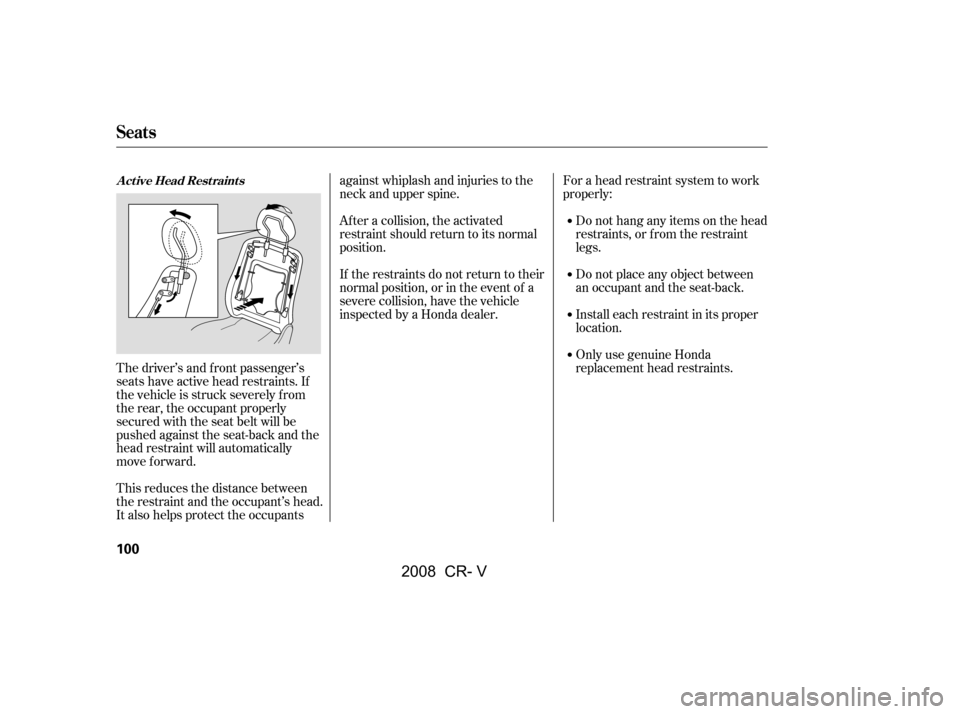Page 55 of 373

Does the shoulder belt cross
between the child’s neck and arm?
Is the lap part of the belt as low as
possible, touching the child’s
thighs?
Will the child be able to stay
seated like this f or the whole trip?
If you answer yes to all these
questions, the child is ready to wear
the lap/shoulder belt correctly. If
you answer no to any question, the
child needs to ride on a booster seat. A child who has outgrown a f orward- f acing child seat should ride in a
back seat and use a booster seat
until the lap/shoulder belt f its them
properly without the booster.Booster seats can be high-back or
low-back. Whichever style you select,
make sure the booster seat meets
f ederal saf ety standards (see page
) and that you f ollow the booster
seat maker’s instructions. Some states and Canadian provinces
also require children to use a booster
seat until they reach a given age or
weight (e.g., 6 years or 60 lbs). Be
sure to check current laws in the
states or provinces where you intend
to drive.
If a child who uses a booster seat
must ride in f ront, move the vehicle
seat as far back as possible and be
sure the child is wearing the seat
belt properly.
3.
4.
5.
41
CONT INUED
Using a Booster Seat
Protecting L arger Children
Driver and Passenger Saf ety
51
�����—�����—�����y�
�������������y���
�(�,�����
���y���������y
2008 CR- V
Page 56 of 373

A child may continue using a booster
seat until the tops of their ears are
even with the top of the vehicle’s or
booster’s seat-back. A child of this
height should be tall enough to use
the lap/shoulder belt without a
booster seat.
The National Highway Traffic Safety
Administration and Transport
Canada recommend that all children
aged 12 and under be properly
restrained in a back seat.
If the passenger’s front airbag
inf lates in a moderate to severe
f rontal collision, the airbag can cause
serious injuries to a child who is
unrestrained, improperly restrained,
sitting too close to the airbag, or out
of position.A side airbag also poses risks. If any
part of a larger child’s body is in the
path of a deploying side airbag, the
child could receive possibly serious
injuries.
Of course, children vary widely. And
while age may be one indicator of
when a child can saf ely ride in f ront,
there are other important f actors you
should consider.
Physically, a child must be large
enough f or the lap/shoulder belt to
properly f it (see pages and ). If
the seat belt does not f it properly,
with or without the child sitting on a
booster seat, the child should not sit
in f ront.
To saf ely ride in f ront, a child must
be able to f ollow the rules, including
sitting properly, and wearing the seat
belt properly throughout a ride.If you decide that a child can saf ely
ride up f ront, be sure to:
Caref ully read the owner’s manual,
and make sure you understand all
seat belt instructions and all saf ety
inf ormation.
Move the vehicle seat to the rear-
most position.
Have the child sit up straight, back
against the seat, and feet on or
near the f loor.
Check that the child’s seat belt is
properly and securely positioned.
Supervise the child. Even a mature
child sometimes needs to be
reminded to f asten the seat belt or
sit properly.
1450
When Can a L arger Child Sit in
Front
Physical Size
Maturity
Protecting L arger Children
52
�\f���—�\f���—�����y�
������\f������y���
�(�,�����
�\f�y�\f�\f�����y
2008 CR- V
Page 57 of 373
This could result
in serious neck injuries during a
crash.
This could
cause very serious injuries during
a crash. It also increases the
chance that the child will slide
under the belt in a crash and be
injured.
If they do, they
could be very seriously injured in a
crash. Devices intended to
improve a child’s comf ort or
reposition the shoulder part of a
seat belt can make the belt less
ef f ective and increase the chance
of serious injury in a crash.
Additional Saf ety Precautions
Do not let a child wear a seat belt
across t he neck.
Do not let a child put the shoulderpart of a seat belt behind t he backor under t he arm.
T wo children should never use thesame seat belt . Do not put any accessories on a
seat belt.
Protecting L arger Children
Driver and Passenger Saf ety
53
�\f���—�\f���—�����y�
������\f����\f�y���
�(�,�����
�\f�y�\f�\f�����y
2008 CR- V
Page 63 of 373

�Î�Î
�Î
The U.S. instrument panel is shown. Dif f erences f or the Canadian models are noted in the text.
:
Instrument Panel
Inst rument s and Cont rols
59
IMMOBILIZER
SYSTEM
INDICATOR TPMS
INDICATOR SUPPLEMENTAL
RESTRAINT
SYSTEM
INDICATOR
LOW TIRE
PRESSURE
INDICATOR
PARKING BRAKE
AND BRAKE
SYSTEM
INDICATOR ANTI-LOCK BRAKE SYSTEM
INDICATOR
DOOR AND
TAILGATE
OPEN
MONITOR DAYTIME RUNNING LIGHTS
INDICATOR
VEHICLE STABILITY ASSIST
(VSA) SYSTEM INDICATOR
SECURITY
SYSTEM
INDICATOR SIDE AIRBAG
OFF INDICATOR
(P.63) (P.61)
(P.64) (P.64)(P.61)
(P.61)
(P.62)
(P.61)
(P.63)
(P.62)
MAINTENANCE MINDER INDICATOR
(P.65)
CRUISE CONTROL INDICATOR
(P.62)
VSA ACTIVATION INDICATOR
(P.62)
LIGHTS ON INDICATOR
(P.64)
MALFUNCTION
INDICATOR LAMP
HIGH BEAM
INDICATOR
(P.63)
LOW FUEL
INDICATOR
(P.63)
LOW OIL
PRESSURE
INDICATOR
CHARGING
SYSTEM
INDICATOR SEAT BELT
REMINDER
INDICATOR
(P.60)
(P.325)
(P.60,324)
(P.60,324)
(P.60,326) (P.65,220)CRUISE MAIN INDICATOR
�\f���—�\f���—�����y�
������
����\f�y���
�(�,�����
�\f�y�\f�\f�����y
2008 CR- V
Page 64 of 373

The instrument panel has many
indicators that give you important
inf ormation about your vehicle.
See page .
If this indicator comes on when the
engine is running, the battery is not
being charged. For more inf ormation,
see page .
The engine can be severely damaged
if this indicator f lashes or stays on
when the engine is running. For
more information, see page .This indicator comes on when you
turn the ignition switch to the ON
(II) position. It reminds you and your
passengers to f asten your seat belts.
A beeper also sounds if you have not
f astened your seat belt.
If you turn the ignition switch to the
ON (II) position bef ore f astening
your seat belt, the beeper sounds,
and the indicator f lashes. If you do
notfastenyourseatbeltbeforethe
beeper stops, the indicator stops
f lashing but remains on.
If your f ront passenger does not
f asten their seat belt, the indicator
comes on about 6 seconds af ter the
ignition switch is turned to the ON
(II) position.
This indicator has two f unctions:
Itcomesonwhenyouturnthe
ignition switch to the ON (II)
position. It is a reminder to check
the parking brake. A beeper
sounds if you drive with the
parking brake not f ully released.
Driving with the parking brake not
fully released can damage the
brakes and tires.
If it stays on after you have fully
released the parking brake while
the engine is running, or if it
comes on while driving, there
could be a problem with the brake
system. For more inf ormation, see
page .
2.
1.
325
324
324 326
Malf unction Indicator
Lamp
L ow Oil Pressure
Indicator
Charging System
Indicator
Seat Belt Reminder
Indicator
Parking Brake and
Brake System
Indicator
Instrument Panel Indicators
60
U.S. Canada
�\f���—�\f���—�����y�
���������\f�
�y���
�(�,�����
�\f�y�\f�\f�����y
2008 CR- V
Page 65 of 373

If either of you do not f asten your
seat belt while driving, the beeper
will sound and the indicator will f lash
again at regular intervals. For more
inf ormation, see page .
This indicator comes on brief ly when
you turn the ignition switch to the
ON (II) position. If it comes on at
any other time, it indicates a
potential problem with your f ront
airbags. This indicator will also alert
you to a potential problem with your
side airbags, passenger’s side airbag
cutof f system, side curtain airbags,
automatic seat belt tensioners,
driver’s seat position sensor, or the
f ront passenger’s weight sensors.
For more inf ormation, see page .This indicator normally comes on f or
a f ew seconds when you turn the
ignition switch to the ON (II)
position, and when the ignition
switch is turned to the START (III)
position. If it comes on at any other
time, there is a problem in the ABS.
If this happens, have your vehicle
checked by your dealer. With the
indicator on, your vehicle still has
normal braking ability but no anti-
lock. For more inf ormation, see page
.
This indicator comes on brief ly when
you turn the ignition switch to the
ON (II) position. If it comes on at
any other time, it indicates that the
passenger’s side airbag has
automatically shut off. For more
inf ormation, see page .
This indicator comes on brief ly when
you turn the ignition switch to the
ON (II) position. It will then go of f if
you have inserted a properly-coded
ignition key. If it is not a properly-
coded key, the indicator will blink,
and the engine’s f uel system will be
disabled (see page ).
18
3180 31
254
Instrument Panel Indicators
Supplemental Restraint
System Indicator Anti-lock Brake System
(A BS) Indicator
Immobilizer System
Indicator Side Airbag Of f
Indicator
Inst rument s and Cont rols
61
Canada
U.S.
�\f���—�\f���—�����y�
���������
�
�y���
�(�,�����
�\f�y�\f�\f�����y
2008 CR- V
Page 100 of 373
When using the center seating
position, adjust the lef t and right side
of the rear seats to the same position.
Make sure all rear shoulder belts are
positioned in f ront of the rear seat-
backs af ter you adjust the rear seats.The height of your driver’s seat is
adjustable. To raise the seat,
repeatedly pull up the lever on the
outside of the seat cushion. To lower
the seat, push the lever down
repeatedly.Each front seat has an armrest on
thesideof theseat-back.Touseit,
pivotitdown.
Driver’s Seat Height A djustment A rmrests
Seats
96
FRONT
�\f���—�\f���—�����y�
���������\f���y���
�(�,�����
�\f�y�\f�
�\f�
�y
2008 CR- V
Page 104 of 373

The driver’s and f ront passenger’s
seats have active head restraints. If
the vehicle is struck severely f rom
the rear, the occupant properly
secured with the seat belt will be
pushed against the seat-back and the
head restraint will automatically
move forward.
This reduces the distance between
the restraint and the occupant’s head.
It also helps protect the occupantsagainst whiplash and injuries to the
neck and upper spine.
Af ter a collision, the activated
restraint should return to its normal
position.
If the restraints do not return to their
normal position, or in the event of a
severe collision, have the vehicle
inspected by a Honda dealer.
For a head restraint system to work
properly:
Do not hang any items on the head
restraints, or f rom the restraint
legs.
Do not place any object between
an occupant and the seat-back.
Install each restraint in its proper
location.
Only use genuine Honda
replacement head restraints.
Seats
A ct ive Head Rest raint s
100
�\f���—�\f���—�����y�
�������������y���
�(�,�����
�\f�y�\f�
�\f���y
2008 CR- V